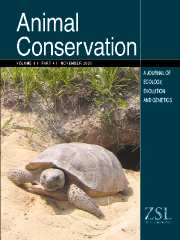Article contents
Estimating breeding population size of the red-crested pochard (Netta rufina) in the Camargue (southern France) taking into account detection probability: implications for conservation
Published online by Cambridge University Press: 29 October 2003
Abstract
The red-crested pochard (Netta rufina), a Eurasian diving duck, has seen its numbers declining and has received strong conservation concern. Data on population size and rate of decline are required to establish management plans, none of which is available for this species. Here we present the first population size estimate taking into account detection probability and habitat use in the Camargue, southern France. A non-random sample of 33 lakes was used to estimate detection probability from point-counts. Detectability was low, with only 57.5% of individual broods detected. A random sample of 37 lakes was then used to estimate brood densities. Adjusted densities (taking into account detection probability) were 0.1106 broods per ha of reedbed. Adjusted densities were extrapolated to the entire surface area of reedbeds in the Camargue estimated from a GIS to obtain abundance estimates of the brood population. A minimum estimate of 559 breeding pairs was obtained (95% confidence interval: 436-855). This estimate is much higher than previous ones (80-100 pairs for the Camargue, 250 pairs for France), and indicates strong underestimation of the population size when not taking into account detectability. Our results suggest that the red-crested pochard may require a reassessment of its conservation status for France and Europe. They further suggest that taking detection probability into account in population estimates of other cryptic species, and notably those of conservation concern, may help clarify their conservation status and may even affect the setting of conservation priorities.
- Type
- Research Article
- Information
- Copyright
- © 2003 The Zoological Society of London
- 10
- Cited by


